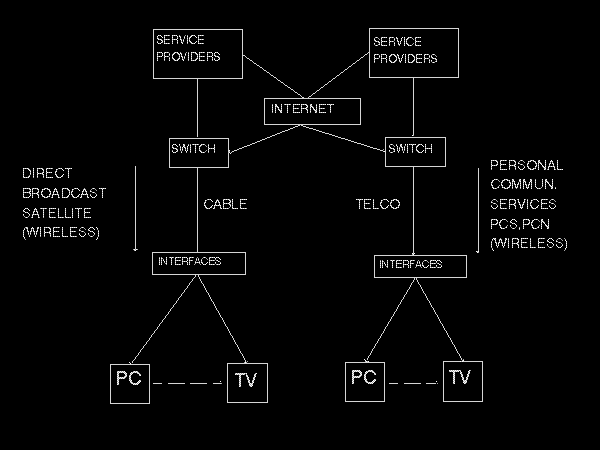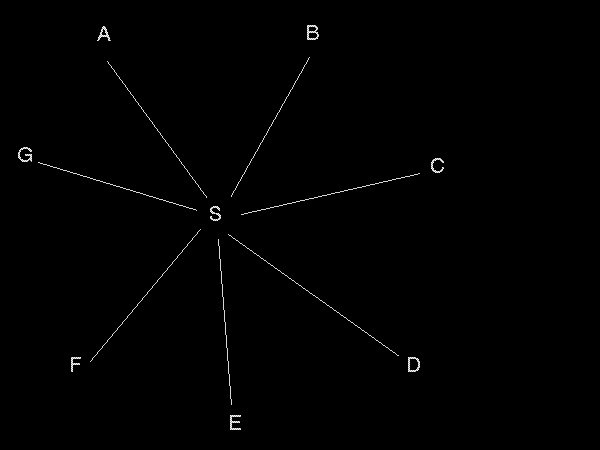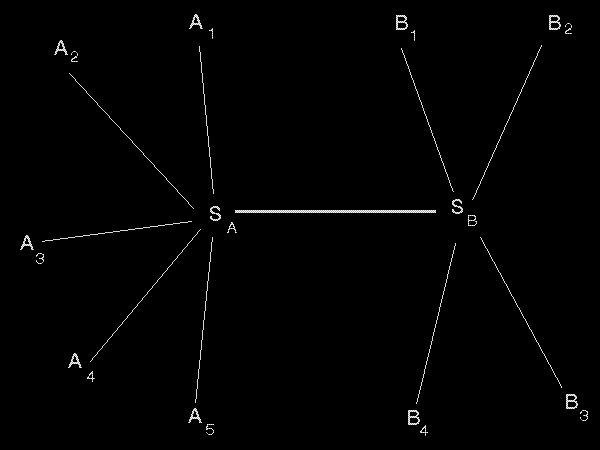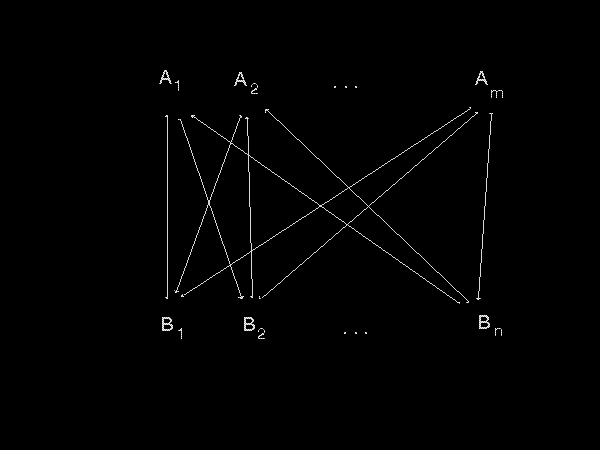
2. Classification of Networks

Figure 1: An information superhighway.
Formally, networks are composed of links that connect nodes. It is inherent in the structure of a network that many components of a network are required for the provision of a typical service. Thus, network components are complementary to each other. Figure 1, represents the emerging Information Superhighway network. Clearly, services demanded by consumers are composed of many complementary components. For example, interactive ordering while browsing in a "department store" as it appears in successive video frames requires a number of components: a database engine at the service provider, transmission of signals, decoding through an interface, display on a TV or computer monitor, etc. Clearly, there are close substitutes for each of these components; for example, transmission can be done through a cable TV line, a fixed telephone line, a wireless satellite, PCN, etc.; the in-home interface may be a TV-top box or an add-on to a PC, etc. It is likely that the combinations of various components will not result in identical services. Thus, the information superhighway will provide substitutes made of complements; this is a typical feature of networks.
Figure 2 shows a simple star telephone network. A phone call from A to B is composed of AS (access to the switch of customer A), BS (access to the switch of customer B), and switching services at S. Despite the fact that goods AS and BS look very similar and have the same industrial classification, they are complements and not substitutes. 3

Figure 2: A simple star network.
Networks where services AB and BA are distinct are named "two-way" networks in Economides and White (1994). Two-way networks include railroad, road, and many telecommunications networks. When one of AB or BA is unfeasible, or does not make economic sense, or when there is no sense of direction in the network so that AB and BA are identical, then the network is called a one-way network. In a typical one-way network, there are two types of components, and composite goods are formed only by combining a component of each type, and customers are often not identified with components but instead demand composite goods. For example, broadcasting and paging are one-way networks.4

Figure 3: A simple local and long distance network.
The classification in network type (one-way or two-way) is not a function of the topological structure of the network. Rather, it depends on the interpretation of the structure to represent a specific service. For example, the network of Figure 3 can be interpreted as a two-way telephone network where SA represents a local switch in city A, Ai represents a customer in city A, and similarly for SB and Bj.5 In this network, there are two types of local phone calls AiSAAk and BjSBBl, as well as long distance phone call AiSASBBj. We can also interpret the network of Figure 3 as an Automatic Teller Machine network. Then a transaction (say a withdrawal) from bank Bj from ATM Ai is AiSASBBj. Connections AiSAAk and BjSBBl may be feasible but there is no demand for them.

Figure 4: A pair of vertically-related markets.
We have pointed out earlier that the crucial relationship in both one-way and two-way networks is the complementarity between the pieces of the network. This crucial economic relationship is also often observed between different classes of goods in non-network industries. In fact, Economides and White (1994) point out that a pair of vertically-related industries is formally equivalent to a one-way network. Figure 4 can represent two industries of complementary goods A and B, where consumers demand combinations AiBj. Notice that this formulation is formally identical to our long-distance network of Figure 3 in the ATM interpretation.
The discussion so far was carried under the assumption of compatibility, i.e., that various links and nodes on the network are costlessly combinable to produce demanded goods. We have pointed out that links on a network are potentially complementary, but it is compatibility that makes complementarity actual. Some network goods and some vertically related goods are immediately combinable because of their inherent properties. However, for many complex products, actual comlementarity can be achieved only through the adherence to specific technical compatibility standards. Thus, many providers of network or vertically-related goods have the option of making their products partially or fully incompatible with components produced by other firms. This can be done through the creation of proprietary designs or the outright exclusion or refusal to interconnect with some firms.
Traditionally, networks were analyzed under the assumption that each network was owned by a single firm. Thus, economic research focussed on efficient use of the network structure as well as on the appropriate allocation of costs.6 In the '70s, partly prompted by the antitrust suit against AT&T, there was a considerable amount of research on economies of scope, i.e., on the efficiency gains from joint operation of complementary components of networks.7
Once one of the most important networks (the AT&T telecommunications network in the US) was broken to pieces, economic research focused in the '80s and '90s on issues of interconnection and compatibility. Similar research on issues of compatibility was prompted by the reduced role of IBM in the '80s and '90s in the setting of technical standards in computer hardware and software. Significant reductions in costs also contributed and will contribute to the transformation toward fragmented ownership in the telecommunications sector in both the United States and abroad. Costs of transmission have fallen dramatically with the introduction of fiberoptic lines. Switching costs have followed the fast cost decreases of microchips and integrated circuits. These cost reductions have transformed the telecommunications industry from a natural monopoly to an oligopoly. The same cost reductions have made many new services, such as interactive video and interactive games, feasible at low cost. Technological change now allows for joint transmission of digital signals of various communications services. Thus, the monopoly of the last link closest to home is in the process of being eliminated,8 since both telephone lines and cable lines (and in some cases PCS and terrestrial satellites) will provide similar services. 9, 10
In a network where complementary as well as substitute links are owned by different firms, the questions of interconnection, compatibility, interoperability, and coordination of quality of services become of paramount importance. We will examine these issues in detail in the next few sections. We first focus on a fundamental property of networks, i.e., the fact that they exhibit network externalities.